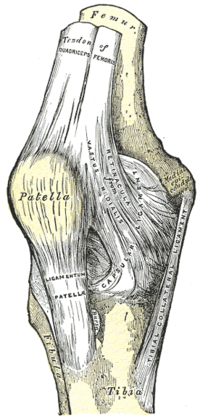
Photo from wikipedia
Objectives: It is unclear what the optimal graft choice is for performing a transphyseal ACL reconstruction in a skeletally immature patient. The purpose of the current study was to evaluate… Click to show full abstract
Objectives: It is unclear what the optimal graft choice is for performing a transphyseal ACL reconstruction in a skeletally immature patient. The purpose of the current study was to evaluate outcomes and complications of skeletally immature patients undergoing an ACL reconstruction with hamstring tendon autograft versus quadriceps tendon autograft. Methods: Between 2012 and 2016, 104 skeletally immature patients from a single institution underwent a primary transphyseal ACL reconstruction with either quadriceps tendon autograft or hamstring tendon autograft based on surgeon preference. Patient demographic, injury, radiographic, and surgical variables were documented. Outcome measures included Lysholm score, SANE score, pain score, satisfaction, return to sport, and complications such as graft tears and physeal abnormalities. Results: Ninety patients (87%) including 62 hamstring tendon reconstructions and 28 quadriceps tendon reconstructions were available for a minimum follow-up of 2 years. The mean age of the patients was 14.8±1.3 years. No differences in chronologic age, bone age, gender, patient size, or mechanism of injury were noted between patient groups. There were no differences in surgical variables except the quadriceps tendon grafts were larger than the hamstring tendon grafts (9.6 mm vs 7.8 mm; p<0.001). Patient outcomes at a mean follow-up of 2.8 years revealed no differences based graft type with a mean Lysholm score, SANE score, pain score, satisfaction, and Tegner score were 95, 91, 0.8, 9.3, and 6.9 respectively. While there were no physeal complications in either group, patients undergoing a hamstring tendon autograft reconstruction were more likely to tear their graft (19% vs 0%; p= 0.01). Conclusion: Skeletally immature patients undergoing an ACL reconstruction can be successfully managed with either a quadriceps tendon autograft or a hamstring tendon autograft with good short-term outcomes, relatively high rates of return to sport, and low rates of physeal abnormalities. The primary differences between grafts were that the quadriceps tendon grafts were larger and were associated with a lower retear rate. Although a relatively new graft source for skeletally immature ACL reconstructions, the quadriceps tendon is not only a viable graft option, but it may be superior to the hamstrings tendon when it comes to early graft failures.
Journal Title: Orthopaedic Journal of Sports Medicine
Year Published: 2019
Link to full text (if available)
Share on Social Media: Sign Up to like & get
recommendations!